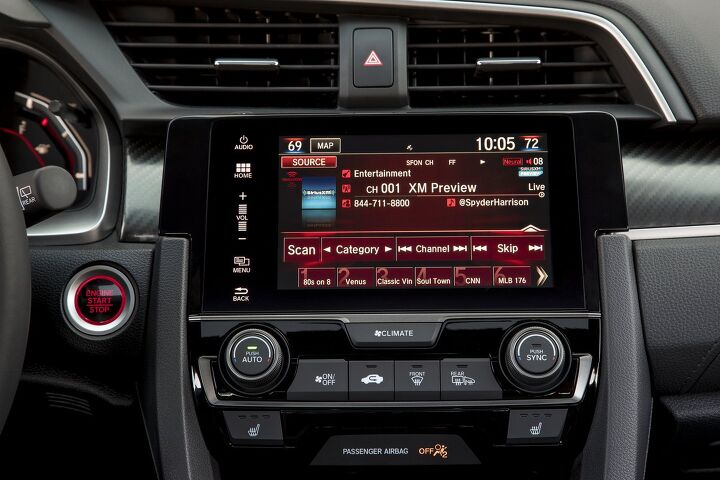AAA Study Finds Infotainment Systems Dangerously Distracting

Automobiles are more tech-laden than ever and, according to a recent study, those interactive bells and whistles contribute heavily to distracted driving.
With connected cars ready to shoot off assembly lines and into driveways at an accelerated pace, the danger of someone flicking through their dashboard menus when they should be looking at the road is only going to grow. Many states prohibit phone usage while driving, yet there is no law against setting your radio pre-tunes or customizing your digital dashboard while hurtling down the expressway — not that there necessarily should be.
However, the American Automobile Association’s Foundation for Traffic Safety commissioned researchers from the University of Utah to examine the physical and mental demand required to complete various tasks using the infotainment systems in 30 new 2017 vehicles. The conclusion was that the growing cavalcade of buttons, screens, and technology does an incredibly good job at keeping you from minding the road ahead.
The AAA study found that programming a vehicle’s navigation was the most distracting task, taking an average of 40 seconds for drivers to complete effectively. That’s quite a bit of time to attempt multitasking, especially when navigation is just one of many potential distractions in a modern car.
“Some in-vehicle technology can create unsafe situations for drivers on the road by increasing the time they spend with their eyes and attention off the road and hands off the wheel,” said Dr. David Yang, executive director of the AAA Foundation for Traffic Safety. “When an in-vehicle technology is not properly designed, simple tasks for drivers can become complicated and require more effort from drivers to complete.”
While design is an issue, an intelligent person would likely pull over before they began a deep dive into automotive menus and circumvent this entire problem. But we all know those people who still text and drive or endlessly futz with controls, and no amount of shaming will stop them. They’re a liability and the best OEMs can do is attempt to integrate mobile devices into in-car systems and make them as easy to use as possible.
Unfortunately, not all technologies are created equal. Taking 30 vehicles from all walks of life, the AAA study uncovered that none of their infotainment systems were satisfactorily intuitive and faulted 12 with being highly demanding of a person’s attention.
According to the association, the best solution is to prohibit drivers from using in-car technologies while in motion — making exceptions for “legitimate emergencies or urgent, driving related purposes.” It also encourages automakers to follow the NHTSA’s voluntary guideline of locking out certain features that generate high demand while driving.
That would assuredly make things safer, but OEMs are providing vehicles with the technologies they think people want. No company in its right mind would strip a vehicle of features when the rest of the competition isn’t doing the same.
That leaves manufactures with the burden of trying to figure out how to make their systems the more intuitive and less taxing. But that’s not going to be easy in the midst of an industry-wide technological arms race. People buy cars based on features, whether or not they even understand or use them.
A new public opinion survey, also from AAA, acknowledges this truth. Over 70 percent of respondents said they definitely want those new technologies in their vehicle, but only 24 percent felt that the systems already in place worked effectively.
“Drivers want technology that is safe and easy to use, but many of the features added to infotainment systems today have resulted in overly complex and sometimes frustrating user experiences for drivers,” said Marshall Doney, AAA’s president and CEO.
However, let’s be pragmatic here. Automakers have already come up with solutions that don’t involve holding a small device inches from your face to navigate roadways or make a phone call. At worst, the additional problem associated with vehicles possessing more buttons and menus were created in the wake of resolving another.
Our low-tech solution is to just pull over if you need to do something more involved than changing the radio station. In the meantime, manufactures will get better at making more intuitive infotainment solutions and you can shop around until you find one that is minimally taxing to interact with — or the government can just ban them, if you prefer.
[Images: Audi; Honda]

A staunch consumer advocate tracking industry trends and regulation. Before joining TTAC, Matt spent a decade working for marketing and research firms based in NYC. Clients included several of the world’s largest automakers, global tire brands, and aftermarket part suppliers. Dissatisfied with the corporate world and resentful of having to wear suits everyday, he pivoted to writing about cars. Since then, that man has become an ardent supporter of the right-to-repair movement, been interviewed on the auto industry by national radio broadcasts, driven more rental cars than anyone ever should, participated in amateur rallying events, and received the requisite minimum training as sanctioned by the SCCA. Handy with a wrench, Matt grew up surrounded by Detroit auto workers and managed to get a pizza delivery job before he was legally eligible. He later found himself driving box trucks through Manhattan, guaranteeing future sympathy for actual truckers. He continues to conduct research pertaining to the automotive sector as an independent contractor and has since moved back to his native Michigan, closer to where the cars are born. A contrarian, Matt claims to prefer understeer — stating that front and all-wheel drive vehicles cater best to his driving style.
More by Matt Posky
Latest Car Reviews
Read moreLatest Product Reviews
Read moreRecent Comments
- 1995 SC I will say that year 29 has been a little spendy on my car (Motor Mounts, Injectors and a Supercharger Service since it had to come off for the injectors, ABS Pump and the tool to cycle the valves to bleed the system, Front Calipers, rear pinion seal, transmission service with a new pan that has a drain, a gaggle of capacitors to fix the ride control module and a replacement amplifier for the stereo. Still needs an exhaust manifold gasket. The front end got serviced in year 28. On the plus side blank cassettes are increasingly easy to find so I have a solid collection of 90 minute playlists.
- MaintenanceCosts My own experiences with, well, maintenance costs:Chevy Bolt, ownership from new to 4.5 years, ~$400*Toyota Highlander Hybrid, ownership from 3.5 to 8 years, ~$2400BMW 335i Convertible, ownership from 11.5 to 13 years, ~$1200Acura Legend, ownership from 20 to 29 years, ~$11,500***Includes a new 12V battery and a set of wiper blades. In fairness, bigger bills for coolant and tire replacement are coming in year 5.**Includes replacement of all rubber parts, rebuild of entire suspension and steering system, and conversion of car to OEM 16" wheel set, among other things
- Jeff Tesla should not be allowed to call its system Full Self-Driving. Very dangerous and misleading.
- Slavuta America, the evil totalitarian police state
- Steve Biro I have news for everybody: I don't blame any of you for worrying about the "gummint" monitoring you... but you should be far more concerned about private industry doing the same thing.



































Comments
Join the conversation
Wanna have some real fun. Try getting a rental car now a days. Even better get into one after say 6 or 7 hour flight at night. Forget trying to find an owners manual in any of these things. Thank god for KIA forte base models. Get this, they still have real honest to goodness knobs to do things like turn the heat or tune a radio. What a concept Fords are the worst.
The good news for manufacturers is that cars now come with black boxes. They will know the conditions of your crash while you were distracted with all their great technology.